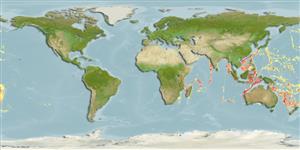Classification / Names
Nombres comunes | Sinónimos | Catalog of Fishes(Género, Especie) | ITIS | CoL | WoRMS | Cloffa
>
Gadiformes (Cods) >
Macrouridae (Grenadiers or rattails)
Etymology: Mataeocephalus: Greek, maa, mataio = silliness + Greek,kepahle = head (Ref. 45335); cristatus: Name from Latin crista for crest, referring to the slightly enlarged middle row of spinules on most body scales.
More on authors: Sazonov, Shcherbachev & Iwamoto.
Environment: milieu / climate zone / depth range / distribution range
Ecología
marino bentopelágico; rango de profundidad 1000 - 1720 m (Ref. 75667). Tropical
Indo-West Pacific: Indian Ocean (Saya de Malha Bank, Mascarene Ridge, Markus-Necker Ridge, Ninety East Ridge); Western Pacific (South China Sea),
Tamaño / Peso / Age
Maturity: Lm ? range ? - ? cm
Max length : 27.1 cm TL macho / no sexado; (Ref. 75667)
Life cycle and mating behavior
Madurez | Reproducción | Puesta | Huevos | Fecundidad | Larva
Sazonov, Y.I., Y.N. Shcherbachev and T. Iwamoto, 2003. The grenadier genus Mataeocephalus Berg, 1898 (Teleostei, Gadiformes, Macrouridae), with descriptions of two new species. Proc. Calif. Acad. Sci., v. 54 (no. 17):279-301. (Ref. 75667)
IUCN Red List Status (Ref. 130435: Version 2024-2)
Threat to humans
Harmless
Human uses
Herramientas
Special reports
Download XML
Fuentes de Internet
Estimates based on models
Preferred temperature (Ref.
123201): 2.5 - 5.2, mean 3.8 °C (based on 352 cells).
Phylogenetic diversity index (Ref.
82804): PD
50 = 0.5156 [Uniqueness, from 0.5 = low to 2.0 = high].
Bayesian length-weight: a=0.00575 (0.00194 - 0.01707), b=3.08 (2.83 - 3.33), in cm total length, based on LWR estimates for this (Sub)family-body shape (Ref.
93245).
Nivel trófico (Ref.
69278): 3.5 ±0.5 se; based on size and trophs of closest relatives
Resiliencia (Ref.
120179): Medio, población duplicada en un tiempo mínimo de 1.4-4.4 años (Preliminary K or Fecundity.).
Fishing Vulnerability (Ref.
59153): Low vulnerability (17 of 100).
